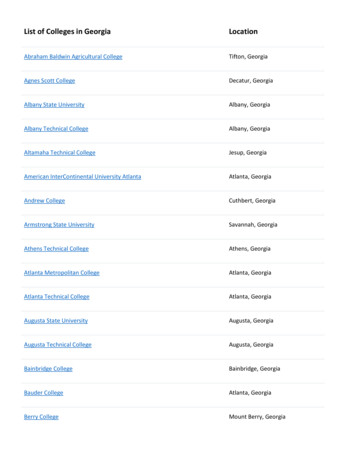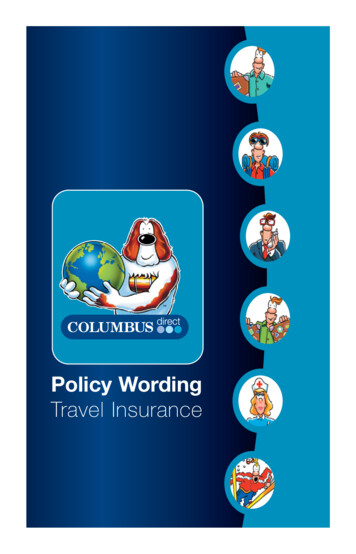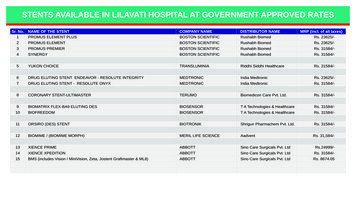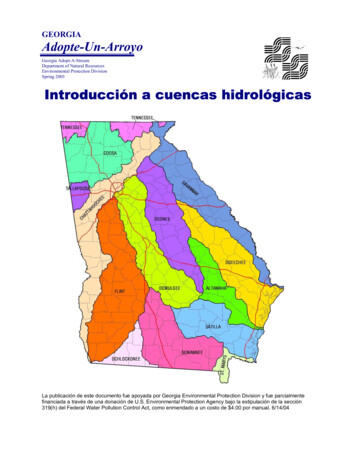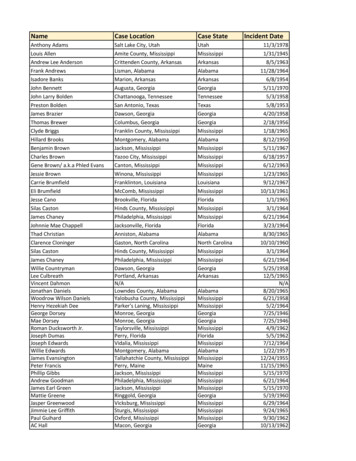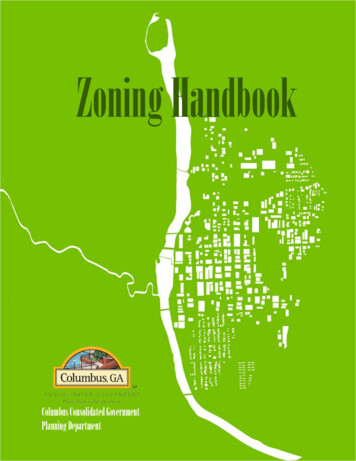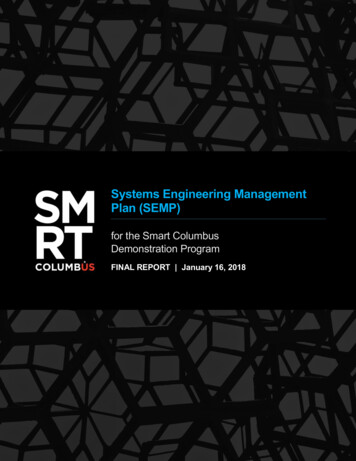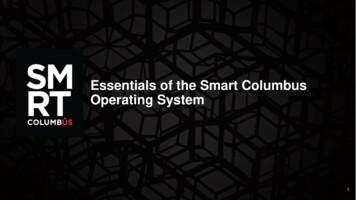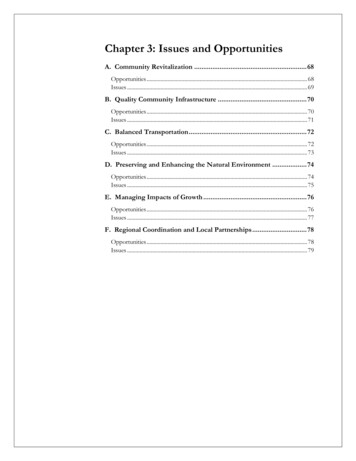
Transcription
Chapter 3: Issues and OpportunitiesA. Community Revitalization . 68Opportunities . 68Issues . 69B. Quality Community Infrastructure . 70Opportunities . 70Issues . 71C. Balanced Transportation . 72Opportunities . 72Issues . 73D. Preserving and Enhancing the Natural Environment . 74Opportunities . 74Issues . 75E. Managing Impacts of Growth . 76Opportunities . 76Issues . 77F. Regional Coordination and Local Partnerships . 78Opportunities . 78Issues . 79
This page was intentionally left blank for two-sided printing.
Community Agenda October 2008This list of Issues and Opportunities, together with the Vision Statement andCommunity Goals, form the backbone of the Community Agenda for theComprehensive Plan. Chapter 3: Issues and OpportunitiesThe Issues and Opportunities for the Columbus Consolidated Government‟sCommunity Agenda are presented on the following pages for each of thegoals that support the City‟s Vision and Mission Statement. These issues andopportunities are built upon the issues and opportunities originally identifiedin the Community Assessment and refined based upon guidance from Cityand consultant staff, elected officials and community leaders, and input fromthe Citizens Stakeholder Committee and Technical Review Committees.Community GoalsA. Community RevitalizationB. Quality CommunityInfrastructureC. Balanced TransportationD. Preserving and Enhancing theNatural EnvironmentE. Managing Impacts of GrowthF. Regional Coordination and LocalPartnershipsKey ValuesConservation of NaturalResourcesCitywide UnityHeritage PreservationMulti-Modal MobilityRegional VisionTrust and Confidence in LocalGovernmentCommunity VisionMissionThe City of Columbus will continue tobe a unified city in which all worktogether to achieve common goals andin which individuality and diversity areembraced and respected. It will be aregional center of commerce andculture; a city in which the commitmentto growth and economic development ismatched by the commitment to thehighest quality of life for all citizens.The City of Columbus will fosterleadership, stewardship, and act withopenness, respect, integrity,accountability, and equality. We willdevelop and ensure the highest possiblequality of life for our citizens with a safeand healthy environment. We willprovide an efficient and effectivegovernment with responsive servicesand community partnerships.Issues and Opportunities67
Community Agenda October 2008A. Community RevitalizationOpportunitiesA-1) New Growth is Coming. There is a large amount of newgrowth coming to Columbus because of Fort Benning‟sincreased troop strength, expansion of Aflac, and the new Kiaplant. This provides a potentially stronger set of market forcesthat could spur revitalization.Available land within in-townneighborhoods can beredeveloped.A-2) Changing Demographics. Changing demographics for thenext 20 years will lead to an increase in small householdscomprised of young singles and couples as well as older “emptynesters” who are more likely to prefer in-town housing to houseson larger lots in the outlying areas of the city or the countryside.Diverting a large share of this growth to in-town areas willstimulate revitalization and potentially reduce the City‟s cost ofinfrastructure and community services for that growth.A-3) Developable Land in In-Town Neighborhoods. There is anabundance of opportunity to redevelop in-town neighborhoodsin Columbus and strong community support for revitalization.A-4) Preservation of Existing Housing Stock. Much of the olderhousing stock in the city‟s in-town neighborhoods is sound andoffers neighborhood qualities that are not found in manycontemporary subdivisions. In-town revitalization shouldprovide the impetus for the City to strengthen and extend itsefforts to encourage owners to preserve and refurbish theseolder homes and improve the quality of in-town neighborhoods.Revitalizing older areas of thecity can be accomplished whilerespecting historic resources.A-5) Mixed-Use Development Opportunities. Columbus hasalready begun the process of building loft housing and mixed-usedevelopment in a number of industrial buildings and warehousesthat had been left empty. The adaptive reuse of these structuresprovides excellent opportunities for additional residential,commercial and civic space near in-town neighborhoods.A-6) Benefits of Revitalization for Historic Resources.Revitalization can respect historic qualities of existing homes andprovide financial impetus to reuse and refurbish historicproperties. Columbus can leverage its numerous historicresources and structures to encourage revitalization in older areasof the city.68Issues and Opportunities
Community Agenda October 2008A-7) Public Perceptions and Marketing. Public perceptions areimportant in strengthening the market for in-town neighborhoodsthat are undergoing revitalization. The City and in-townneighborhood organizations should publicize stories ofsuccessful revitalization partnerships as a way to improve thepublic perceptions concerning these parts of the city.IssuesA-8) Effects of Continuing the Current Growth Trends. Currentgrowth trends suggest that much of the new growth inColumbus will likely occur in Northwest Columbus, thePanhandle and other outlying areas of the city. This wouldleave little market demand to accomplish revitalization of intown neighborhoods that seek revitalization.A-9) Gentrification. Physical redevelopment of in-town areas couldresult in “place prosperity” but not “people prosperity.” Ifgentrification raises the cost of living in-town it may push outcurrent residents and disrupt the social bonds in existingneighborhoods. This could lead to unwanted tension betweennewcomers and existing community residents and causehousing to become overcrowded in other places.A-10) Barriers to Redevelopment. There are many barriers toredevelopment, including land assembly of small,nonconforming lots, the higher cost of land, presence ofbrownfields, high cost of upgrading aging infrastructure in thein-town neighborhoods, and outdated codes and ordinancesthat favor new greenfield suburban development.Current growth trends suggestthat new development will occurin Northwest Columbus and thePanhandle.Barriers to redevelopmentinclude land assembly of small ornonconforming lots, as well asthe presence of brownfields.A-11) Quality of Housing Developments. Some of the newhousing developments being constructed in Columbus lack thecharacteristics and amenities that make them goodneighborhoods – inter-connected street patterns, sidewalks,landscaping, green space and compatible architectural design,and pedestrian access to retail and community services.A-12) Mismatch between Housing and Jobs. There is a mismatchbetween the types of jobs available near in-town Columbusneighborhoods and the housing that is available there. Thisresults in a lack of accessible employment for in-town residentsand a lack of accessible housing for people who work in thecentral business district.Issues and OpportunitiesNew housing within in-townneighborhoods will require higherdensities to achieve financialfeasibility.69
Community Agenda October 2008A-13) Lack of Resources to Fund Needed Revitalization Efforts.Revitalization efforts will require a steady supply of funding toimprove the quality of in-town facilities and supportpublic/private partnerships. There has been a reduction in stateand federal funding, so new efforts are needed to seek additionalsources of funds and target resources to achieve revitalization ofin-town neighborhoods in Columbus.A-14) Density Requirements for New Housing. In order for it tobe financially feasible to build new housing within in-townneighborhoods, densities of new housing will need to be greaterthan the density of existing neighborhoods.A-15) Aesthetics/ Streetscape Improvements and OverlayDistricts. Streetscape improvements would improve theappearance, walkability and safety of redevelopment areas.Such improvements are already underway in certain areas of thecity. For example, placing utilities underground on WynntonRoad creates a more welcoming environment for investors,pedestrians, tourists, and others.Streetscape improvements canmake redevelopment areas moreinviting to investors, pedestrians,and tourists.B. Quality Community InfrastructureOpportunitiesB-1) Growth of Fort Benning Provides an Impetus for PublicInvestment. After a number of years of slow or no growth, itis well known that the additional troop strength at Fort Benningwill require improving the city‟s infrastructure and communityfacilities to support related growth. This helps the City to justifyadditional requests for infrastructure funding, perhaps bypartnering with Fort Benning and seeking additional federalassistance.Columbus Water Works hasexcess capacity to supportgrowth.70B-2) Columbus has the Opportunity to Use Infrastructure toDirect Growth. Residents of Columbus value existingneighborhoods. The City should intentionally locate publicfacilities in these areas to ensure that these facilities contributeto achieving the community‟s desired development patterns andensure the viability of in-town neighborhoods.B-3) Columbus Could Employ Performance-Based LandDevelopment Controls. While seeking funding for bettercommunity infrastructure, the City also has the opportunity toupdate its land development permitting system to take betteradvantage of available infrastructure capacity. A performancebased land development system could use land-use change toimprove the utilization of existing infrastructure. Please seeAppendix C for more information on this topic.Issues and Opportunities
Community Agenda October 2008B-4) The City of Columbus has a Strong and Viable WaterUtility. The Columbus Water Works is well-run and has excesscapacity that can be used to support growth at Fort Benning andthroughout the city. It could also be expanded to serve watersupply needs of adjacent jurisdictions.IssuesB-5) Aging Infrastructure. The City has deferred maintenance onmuch of its infrastructure. Aging infrastructure needs to beupdated and repaired to address existing deficiencies andprovide capacity for growth. Higher densities will place greaterstrain on existing infrastructure.B-6) Rising Cost of Facility Operations and Maintenance Cost.The cost of maintaining infrastructure continues to rise. Newinfrastructure and facilities will be built to serve population andjob growth. This increases the total stock of public facilities. Inaddition to current facilities, new facilities will also need to bestaffed, operated, and maintained over time. In the future,additional revenues will be needed to pay for construction ofnew public facilities and provide for their long-term operationand maintenance.B-7) Mismatch between Public/Private Facilities andNeighborhoods. Most of the new parks and other publicfacilities are too far away to be convenient to in-townneighborhoods. There is a lack of parks and community centerslocated near these in-town neighborhoods. In addition, a lack ofpublic transportation to areas where the new parks are locatedmakes parks more difficult to access by people who live in-town.The cost of maintaining existinginfrastructure continues to rise,while new facilities need to beconstructed to serve populationgrowth.New schools are underconstruction in the suburbs,while many in-town schools areunderutilized.B-8) Mismatch between New Schools and RevitalizationDesires. While the Muscogee County School District isbuilding new schools in outlying areas, many in-town schools areunderutilized. The new schools will provide a greater impetusfor people to move to outlying areas of Columbus, increasingproblems with sprawl and raising the long-run cost of the City toprovide infrastructure and services.B-9) Security and Public Safety Are Barriers to Redevelopmentand Infill. Safety is a concern for residents in some areas ofColumbus. Additional public safety efforts will be needed tomaintain public safety in these areas. Also, designing sites andbuildings using the principles of Crime Prevention ThroughEnvironmental Design (CPTED) would improve security overtime.Issues and OpportunitiesThe public desires more parksand recreational facilities.71
Community Agenda October 2008B-10) Limited Police Force. In comparison to other cities of itssize, Columbus‟s police force is under-manned. Communitymembers are concerned that the police department isinadequate. Greater police presence is desired.B-11) New Community Facilities Must be More Sensitive toExisting Neighborhoods. The current system of locatingand funding new community facilities and infrastructure insuburban areas overlooks the alternative of improving existingcommunity facilities where more people would be served. Theneeds of existing residents should be considered as strongly asthe needs of newcomers.Existing rail freight yard facilitiesshould be modernized andrelocated.B-12) Recreational Facilities and Parks Improvement.Community members voiced a strong need for parks andrecreational facilities. Improvements and new additions shouldconsider the recreational needs of a changing population –including young singles and couples as well as “empty-nesters.”C. Balanced TransportationOpportunitiesC-1) Better Land Use-Transportation Coordination. A newLand Use Plan and the addition of new growth andrevitalization of existing neighborhoods, corridors, andcommunity centers provide opportunities to re-shape land useand development patterns to be supportive of alternativemodes and more efficient transportation services.The fragmented and incompletepedestrian network createssafety concerns, especially forschool-aged children and transitusers.72C-2) Rising Gasoline Prices and Community Awareness of theNeed for More Sustainable Energy Practices. The publichas become keenly aware of the importance of energyefficiency because of high gasoline prices and public educationregarding the impacts of global climate change. This creates theopportunity to re-design transportation systems to favor moreenergy-efficient alternatives such as public transportation,bicycling, and walking.C-3) Multi-Modal Transportation Facilities. Theimplementation of the proposed rails-to-trails project andadditional walking and biking trails has the ability to improvemulti-modal connectivity throughout Columbus as well asfacilitate revitalization efforts and increase recreationalopportunities.Issues and Opportunities
Community Agenda October 2008C-4) Re-Alignment of Rail Freight Yard Operations. Thecurrent rail yard west of the Central Business District isoutdated and needs to be replaced with a modern facility.Relocating this rail yard could provide several opportunities,including improving the efficiency of freight handling,eliminating some at-grade street crossings, and freeing valuablein-town real estate for better uses.IssuesMore roadway and rail gradeC-5) Incomplete Pedestrian Network. Columbus currently has aseparations are needed tofragmented and incomplete pedestrian network. Incompleteincrease safety and reduceconnections exist between neighborhoods and schools andcongestion.residences and bus stops. Many sidewalks are dangerousbecause they are located close to busy thoroughfares, and manyof these are at the same grade as adjacent roads. Theseconditions limit sidewalk use and pose mobility and safetyconcerns, particularly for school-aged children and those thatrely on transit and walking for daily activities.C-6) Limited Transit Service. A well functioning transit system isa core element to ensuring that Columbus is a full service city.The current METRA system has insufficient routes and hoursof operation to meet the needs of those citizens that depend onThe construction of new roadsthese services. Better transit coordination is also requiredshould be balanced with thebetween Fort Benning and Columbus.maintenance and improvementC-7) Increasing Congestion. Minimizing congestion wasof existing roads.identified as the number one transportation priority from thecommunity involvement program. Congestion will likelyincrease as the local economy and population experiencegrowth.C-8) Balance between New and Existing Road Infrastructure.Growth beyond the central portion of the city has created amismatch between land use and transportation. If greater focusis placed on revitalization, the City will need to balance themaintenance and improvement of existing roads with thedevelopment of new roads.C-9) Traffic Signalization. There are multiple outdated andThe Chattahoochee River is animportant resource.isolated traffic signal systems throughout Columbus. Thesesystems do not currently communicate with a central TrafficControl Center (TCC); however, the City has secured fundingto develop one. An Intelligent Transportation System (ITS)also needs to be established. It should include an upgrade ofoutdated signal control equipment and communications to thefuture TCC.C-10) Roadway and Rail Grade Separation. More roadway and railgrade separations are needed. Currently Columbus has 188public at-grade railroad crossings (Federal Railroad Administration).Issues and Opportunities73
Community Agenda October 2008C-11) Fort Benning Related Traffic. Develop plans toaccommodate new traffic derived from the BRAC (BRACDEIS 2005). These plans should consider and include publictransit routes and hours of operation in and out of the base.C-12) Lack of Available Transportation Funding. Limitedfunding has slowed down the pace of constructing neededtransportation improvements. Rising construction costs and areduction in available federal transportation funding hasresulted in a funding shortfall.Oxbow Meadows creates anopportunity to furtherenvironmental management, aswell as public education.D. Preserving and Enhancing the NaturalEnvironmentOpportunitiesGreenspace should bepreserved as new developmentoccurs in rural areas.Protecting mature trees withinthe city helps to create attractiveand healthy communities.D-1) The Chattahoochee River is the Mainstream ofEcological Health for the Region. The City of Columbushas approximately 21.5 miles of frontage along one of themost beautiful and most threatened urban rivers in theUnited States. The Riverwalk has made this a popular andattractive resource for the entire community, but additionalopportunities exist to connect more of the community to a„riverside experience‟ through expansion of greenways andtrails into a city-wide system that links adjacentneighborhoods, parks and schools to this resource.D-2) Expand Scope of Environmental Management andEnvironmental Education. The City could expand itsenvironmental management and education role. To do this,potential actions should include making greater use ofresources, such as Oxbow Meadows; developing creativepublicity that would improve the connection betweenenvironmental activities and other city service areas; andamending the Unified Development Ordinance to encouragegreater „green‟ development patterns and initiatives. Theseactivities have the potential to positively affect other cityservice areas related to public service, education, tourism, andeconomic development.D-3) Protecting a Green Corridor along I-185. The I-185Corridor provides the visual and aesthetic gateway to visitorsand residents alike. Protecting a wide corridor of greenspacealong I-185 would make a public statement about the „green‟image of the city.74Issues and Opportunities
Community Agenda October 2008D-4) Greenspace Preservation. As new development occurs ingreenfields such as in the Panhandle and Northwest Columbus,the City has the opportunity to use development incentives topermanently preserve greenspace within the new developments.Conservation subdivision design that secures greenspaceeasements would preserve at least 20 percent of the land that issubdivided. A combined policy of conservation subdivisions,in-town revitalization and emphasizing the conversion andreuse of greyfields and brownfields instead of greenfielddevelopment could save over 3,000 acres of greenspace in thenext 20 years.1D-5) Partnerships with Fort Benning. Federal attention has beenfocused on the relationship between the health of the Fort andthe health of the community. There is the potential that thisattention can lead to resources that can be used to preservegreenspace around the base for the mutual benefit of the cityand the military mission of the base.IssuesD-6) Protecting the City’s Tree Canopy. Mature trees are alwaysat risk as a community clears land to build new housing andbusinesses. Preserving mature trees and their related habitat isan important part in maintaining a healthy, functioningecosystem. Mature trees also provide an attractive, healthy, andvaluable amenity to surrounding neighborhoods andcommunities.D-7) Monitoring and Protecting Water Quality as the CityGrows. Columbus will need to step up its efforts to monitorand protect its clean water in the Chattahoochee River andother significant water bodies as new growth takes place. Fiveof the city‟s significant rivers and streams, along with LakeOliver, have been identified as not fully supporting the waterquality standards mandated by the Clean Water Act. It isimportant to buffer these critical water bodies and protect themfrom pollution from urban runoff.D-8) Protecting Steep Slopes and Fragile Soils. Columbus has4,000 acres with slopes 25 percent or greater and 3,000 acreswith slopes that range from 15 percent to 25 percent.2 Thereare also Southern Piedmont Upland Soils with shallow bedrockassociated with these areas, making them more vulnerable toerosion and runoff as well as more difficult and costly land onwhich to build.The future mission of FortBenning will include largeweaponry training which willcreate off-base noise impacts.Growth leads to increasedmunicipal revenues and jobs.1Numbers are based on analysis performed by JJG in Technical Memo dated June 24,2008.2Numbers are based on environmental analysis completed by JJG in 2007. Please seeSection 5.4 of the Community Assessment for more information.Issues and Opportunities75
Community Agenda October 2008D-9) Noise Impacts of Fort Benning’s Future Missions. Thefuture mission of Fort Benning will include training withlarge weaponry, which will have significant noise impacts offthe base. The City and the Fort will need to develop land-usemitigation strategies for these areas.E. Managing Impacts of GrowthOpportunitiesE-1) Growth Increases Tax Base and Municipal Revenues.Growth in population and jobs will inevitably lead to newprivate investment and reinvestment that will increase the taxbase. This creates a growing source of revenues for the Citythat can be tapped for city services and facilities. Theserevenues would largely be expected to go toward providingfacilities and services to satisfy demands resulting from newdevelopment.Developing public trust will berequired to carry out new capitalprojects to improve and developpublic facilities.E-2) Garnering Public Trust in New Funding Mechanisms.Columbus will have to find new sources of revenues to payfor increasing public facility needs. Although this is an issue,it also provides an opportunity to develop a solid process forfunding, budgeting, and managing capital projects through amore sophisticated Capital Improvements Program. There isalso an opportunity to develop new innovative revenuesources that are more efficient and more sustainable. Doingso would provide an opportunity to restore public trust thathas been harmed by public perceptions that previous capitalprojects did not fully meet public expectations.E-3) Columbus Champions. Community survey results,stakeholder interviews, public meeting input, and failure ofrecent referendums in the city highlight the existence ofpublic distrust of the Columbus government and itsdecisions. A citizen led task force, “Columbus Champions,”charged with helping implement the Comprehensive Plancould help minimize public opposition to the implementationof policies, strategies, and projects laid out in theComprehensive Plan. This initiative could potentially becoordinated with other existing, citizen-led growthmanagement groups.76Issues and Opportunities
Community Agenda October 2008IssuesE-4) Increasing Number of School Children. An increasingnumber of school children will enter the Muscogee CountySchool System as BRAC occurs. The City has already initiatedseveral coordination efforts, including the Regional GrowthManagement Plan, to address this issue in partnership otherarea governments and public and private agencies. Despitethese efforts, the lack of local, state, and federal resources willcontinue to limit these initiatives.E-5) Low-Density Residential Zoning. Much of the land inColumbus that is set-aside for residential purposes is zoned forlow-density housing (please see the Future Land Use Plan,Chapter 2.3). Low-density residential development tends tohave higher municipal service costs per housing unit than thesame quality of development at higher density, when it isproperly planned along with jobs, retail services, infrastructure,and services. Density of residential land use will inevitably risewith growth. However, there is a need to plan the location ofmore dense development along with the necessary services andamenities so that it can be successfully integrated with existingneighborhoods and help reduce the cost of public services overthe next five to ten years.Low-density residential zoningcan lead to higher municipalservice costs.E-6) Garnering Public Trust in Capital Project Delivery.Growth will almost certainly require the ColumbusConsolidated Government to carry out new capital projects.The City will have to find sources of revenues to pay forincreasing public facility needs. In the recent past, there hasbeen public perception that some capital projects have not fullymet public expectations. This has led to a problem with publictrust that must be overcome.E-7) Potential Impacts of Raising City Revenues. IncreasingCity revenues to pay for services may require identifying newfunding streams. Should Columbus decide to increase taxes orapprove new funding streams, some businesses and individualsand families may choose to “vote with their feet.” They mayleave Columbus to live in neighboring communities wherecosts are lower (an existing trend that could become morepronounced).The City will need to dedicatefunding for growth-relatedinfrastructure to meet anincreasing demand for services.E-8) Inadequate Revenues. Given its current revenue structure,the City has difficulty addressing the public‟s desire to increasecurrent levels of service. The City is likely to have difficultymeeting future operating needs resulting from newdevelopment, even at current levels of service. In addition, theCity does not have dedicated funding for growth-relatedinfrastructure improvements.Issues and Opportunities77
Community Agenda October 2008E-9) Level of Service. The City must consider its current level ofservices, whether they are adequate or need improvement.As people from other regions of the country relocate toColumbus, they will likely demand the same level of servicesthey received in their previous communities withoutsupporting major changes to taxes. Increasing levels ofservice could be very costly. CCG needs a long-term strategyto review and amend these important service thresholds andto resolve this issue.F. Regional Coordination and LocalPartnershipsOpportunitiesColumbus Water Works shouldtake a leading role in regionalwater planning and provision.Retaining and expanding jobopportunities are key tomaintaining economic growth.78F-1) Preparation for Fort Benning Growth. Fort Benning,Columbus, and other regional partners should continue towork together to ensure that all affected parties are preparedfor base growth.F-2) Chattahoochee Valley Schools Project and Funding forRegional Education. The Muscogee County SchoolDistrict leads the Chattahoochee Valley Schools Project, agroup of seven regional school districts seeking “absolutefunding” from the Department of Education due to anexpected surge in school children due to BRAC.F-3) Regional Water Planning and Water Services. Severalprovisions of t
B-4) The City of Columbus has a Strong and Viable Water Utility. The Columbus Water Works is well-run and has excess capacity that can be used to support growth at Fort Benning and throughout the city. It could also be expanded to serve water supply needs of adjacent jurisdictions. Issues B-5) Aging Infrastructure.
